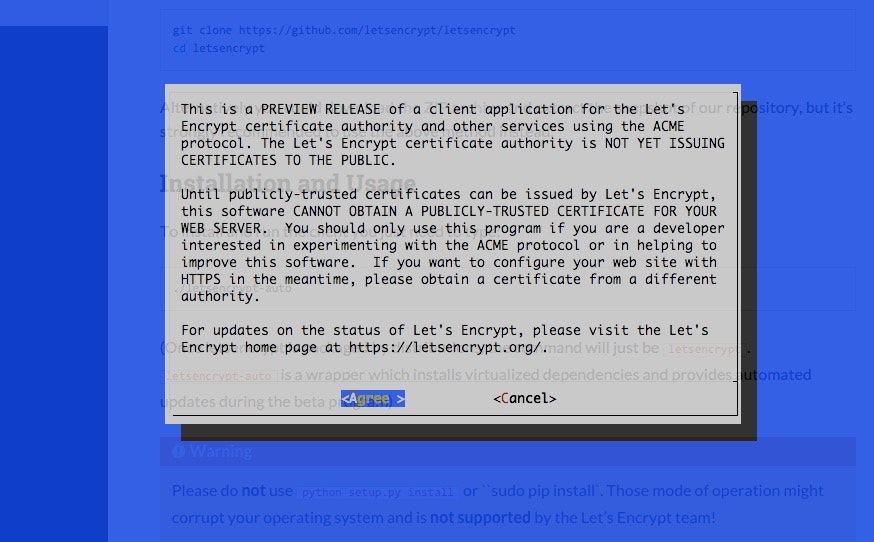この記事ちょいちょい参考にする人いますが相当古いです、普通に下記のcertbotつかってください。
Let's EncryptのCAがじわじわと信頼の手を広げている。
12/3にパブリックベータになったので、記述に追記をいれました。
じゃあそろそろ試そうと、CLIインストールのドキュメント Using the Let’s Encrypt clientを見たらRunning with Dockerというセクションがあった。
t2.microのAmazonLinuxを上げてやってみる。
準備はこのくらい。
- ポート80を開けておこう
- PublicIPをなにかしらDNSで引けるようにしておこう
Dockerデーモンを上げよう。
$ sudo yum -y install docker
$ sudo service docker start
Dockerでletsencryptコマンド実行
$ sudo docker run -it --rm -p 443:443 --name letsencrypt \
-v "/etc/letsencrypt:/etc/letsencrypt" \
-v "/var/lib/letsencrypt:/var/lib/letsencrypt" \
quay.io/letsencrypt/letsencrypt:latest certonly
12/9修正:
authはcertonlyに変わりました。
ついでに、-p 80:80 を追加して、 コマンドラインをcertonly --standaloneとすれば後のPythonWebサーバの手順は不要です。
もうひとつ追記:
Webrootプラグインによる証明書取得は、Webサーバを停止せずに、自動取得ができる。 => Webroot
せやね。
少し待つ。
ぬお、紹介のビデオで見たやつだ。
ホスト名をletsen.opsrockin.comなどと入れると、JSONをWebサーバで返してくれと言われる。 (IPだと駄目なので)
Make sure your web server displays the following content at
http://letsen.opsrockin.com/.well-known/acme-challenge/j0KEGQ8U6_KZBicqFxazIyEo_4FPAC0RvPadG_0SMLE before continuing:
Content-Type header MUST be set to application/jose+json.
If you don't have HTTP server configured, you can run the following
command on the target server (as root):
mkdir -p /tmp/letsencrypt/public_html/.well-known/acme-challenge
cd /tmp/letsencrypt/public_html
echo -n '{JSONの中身}' > .well-known/acme-challenge/j0KEGQ8U6_KZBicqFxazIyEo_4FPAC0RvPadG_0SMLE
# run only once per server:
$(command -v python2 || command -v python2.7 || command -v python2.6) -c \
"import BaseHTTPServer, SimpleHTTPServer; \
SimpleHTTPServer.SimpleHTTPRequestHandler.extensions_map = {'': 'application/jose+json'}; \
s = BaseHTTPServer.HTTPServer(('', 80), SimpleHTTPServer.SimpleHTTPRequestHandler); \
s.serve_forever()"
作ったばかりのインスタンスでまだWebサーバもいないことだし、SimpleHTTPServerさんを使おう。
別のターミナルから、80をlistenするのでrootで起動。
mkdir -p /tmp/letsencrypt/public_html/.well-known/acme-challenge
cd /tmp/letsencrypt/public_html
echo -n '{"JSONの中身"}' > .well-known/acme-challenge/j0KEGQ8U6_KZBicqFxazIyEo_4FPAC0RvPadG_0SMLE
# run only once per server:
$(command -v python2 || command -v python2.7 || command -v python2.6) -c \
"import BaseHTTPServer, SimpleHTTPServer; \
SimpleHTTPServer.SimpleHTTPRequestHandler.extensions_map = {'': 'application/jose+json'}; \
s = BaseHTTPServer.HTTPServer(('', 80), SimpleHTTPServer.SimpleHTTPRequestHandler); \
s.serve_forever()"
Docker側を進めると、Webサーバにリクエストが送られてきていた。
そしてちょっとまつと、サーバ証明書が作られた。
IMPORTANT NOTES:
- Congratulations! Your certificate and chain have been saved at
/etc/letsencrypt/live/letsen.opsrockin.com/fullchain.pem. Your cert
will expire on 2016-01-21. To obtain a new version of the
certificate in the future, simply run Let's Encrypt again.
JSONをつついて、ドメインの所有を確認しているのね。
出来たサーバ証明書を試してみる
使うファイルはこれらかね? fullchainはcert + chainだった。nginxとかで使う形式。
/etc/letsencrypt/live/letsen.opsrockin.com/fullchain.pem
/etc/letsencrypt/live/letsen.opsrockin.com/cert.pem
/etc/letsencrypt/live/letsen.opsrockin.com/chain.pem
/etc/letsencrypt/live/letsen.opsrockin.com/privkey.pem
鍵ペアが使えるかどうか、opensslコマンドでサーバを立てる。
$ sudo openssl s_server -cert /etc/letsencrypt/live/letsen.opsrockin.com/cert.pem -key /etc/letsencrypt/live/letsen.opsrockin.com/privkey.pem -CAfile /etc/letsencrypt/live/letsen.opsrockin.com/chain.pem
Using default temp DH parameters
Using default temp ECDH parameters
ACCEPT
で、同じくクライアントで。
$ openssl s_client
CONNECTED(00000003)
depth=1 CN = happy hacker fake CA
verify error:num=19:self signed certificate in certificate chain
verify return:0
---
Certificate chain
0 s:/CN=letsen.opsrockin.com
i:/CN=happy hacker fake CA
1 s:/CN=happy hacker fake CA
i:/CN=happy hacker fake CA
---
Server certificate
-----BEGIN CERTIFICATE-----
MIIE7TCCA9WgAwIBAgITAPqv3jjriYXOmiuQpfWx6J4vvzANBgkqhkiG9w0BAQsF
ADAfMR0wGwYDVQQDDBRoYXBweSBoYWNrZXIgZmFrZSBDQTAeFw0xNTEwMjMwOTI2
MDBaFw0xNjAxMjEwOTI2MDBaMB8xHTAbBgNVBAMTFGxldHNlbi5vcHNyb2NraW4u
...
---
New, TLSv1/SSLv3, Cipher is ECDHE-RSA-AES256-GCM-SHA384
Server public key is 2048 bit
Secure Renegotiation IS supported
Compression: NONE
Expansion: NONE
SSL-Session:
Protocol : TLSv1.2
...
CA証明書のチェーンが、happy hacker fake CAとなっているが、ちゃんとTLSで接続を確立できた。
さすがにこの状態では使っても普通の自己署名扱いだけど、そのうちfake CAでは無く、次のようなチェインになるのだろう。これで済むならまったくカンタンだね。
12/9 追記: ベータでもチェーンは下記の信頼できるものになりました。
---
Certificate chain
0 s:/CN=letsencrypt.org/O=INTERNET SECURITY RESEARCH GROUP/L=Mountain View/ST=California/C=US
i:/C=US/O=IdenTrust/OU=TrustID Server/CN=TrustID Server CA A52
1 s:/C=US/O=IdenTrust/OU=TrustID Server/CN=TrustID Server CA A52
i:/C=US/O=IdenTrust/CN=IdenTrust Commercial Root CA 1
2 s:/C=US/O=IdenTrust/CN=IdenTrust Commercial Root CA 1
i:/O=Digital Signature Trust Co./CN=DST Root CA X3
ついでに、CLIのヘルプもでる。
エントリーポイントがletsencryptコマンドなので、ヘルプやらもちゃんとでる。
12/9修正: ヘルプ表示内容を更新
$ sudo docker run -it --rm -p 443:443 --name letsencrypt -v "/etc/letsencrypt:/etc/letsencrypt" -v "/var/lib/letsencrypt:/var/lib/letsencrypt" quay.io/letsencrypt/letsencrypt:latest --help
letsencrypt [SUBCOMMAND] [options] [-d domain] [-d domain] ...
The Let's Encrypt agent can obtain and install HTTPS/TLS/SSL certificates. By
default, it will attempt to use a webserver both for obtaining and installing
the cert. Major SUBCOMMANDS are:
(default) run Obtain & install a cert in your current webserver
certonly Obtain cert, but do not install it (aka "auth")
install Install a previously obtained cert in a server
revoke Revoke a previously obtained certificate
rollback Rollback server configuration changes made during install
config_changes Show changes made to server config during installation
plugins Display information about installed plugins
Choice of server plugins for obtaining and installing cert:
--apache Use the Apache plugin for authentication & installation
--standalone Run a standalone webserver for authentication
--nginx Use the Nginx plugin for authentication & installation
--webroot Place files in a server's webroot folder for authentication
OR use different plugins to obtain (authenticate) the cert and then install it:
--authenticator standalone --installer apache
More detailed help:
-h, --help [topic] print this message, or detailed help on a topic;
the available topics are:
all, automation, paths, security, testing, or any of the subcommands or
plugins (certonly, install, nginx, apache, standalone, webroot, etc)
